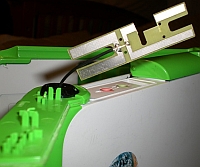In The Tragedy of One Laptop Per Child, Michael Gartenberg at Slashgear just called a million and a half computers in the hands of children, radically transforming education and social structures in dozens of countries, a tragedy. With another million on order. Well, that's not what he said, because he is apparently unaware of these and many other facts. Here.
Look at the issues related to the notion of the $100 laptop (which ended up costing a lot more than a $100 and will continue to do so) such as who will program them? How will they be repaired? What's the courseware and curriculum? Now listen to the answers (mostly, the kids will do it all) and you realize there's a real problem as a good deal of this intended market is illiterate.
These strawman answers to strawman questions turn out to be mostly contrary to fact, except where it turns out that children really can do what Gartenberg derides. I personally find prejudice against children even more appalling than prejudice based on race, gender, or poverty, or any of the other common excuses that we at least talk about.
- Sub-$100 computers have appeared, and will continue to appear. I will bet on Mary Lou Jepsen's engineering and manufacturing judgment over Gartenberg's any day. She was VP for Engineering at OLPC, and is building up a milti-billion-dollar company selling the screen technology she invented while teaching at MIT, and provided for the XO. The Pixel Qi Web site explains their view of the $75 laptop.
When can I buy a $75 laptop? While Pixel Qi has said that it believes a $75 laptop will be ready in 2010. [sic] However Pixel Qi isn't making a $75 laptop. We are making the screens.We are focused on delivering screens to a gamut of low-cost computing platforms to enable lower priced laptops to evolve. Lower cost laptops won't happen without lower priced components and Pixel Qi is tackling the most and expensive [sic] and power hungry one first: the screen. To buy the laptop we suggest you stay in touch with One Laptop per Child.
- "Who will program them?" The Free Software and Open Source communities that created GNU, Linux, BSD Unix, Open Office, Sugar, and tens of thousands of other programs. Funding is currently on offer from the US Dept. of Education and from other sources.
Children can learn programming starting in third grade for sure, and possibly sooner. I can provide references for LISP, Logo, Smalltalk, APL, BASIC, and other languages used in elementary schools off and on since the 1960s. That doesn't mean that the children become experts at that age, but high school students with six years' experience and appropriate guidance will be quite capable of writing some of the software that their own schools will need, and putting out feature requests and new software requests to the Free Software community online.
- "How will they be repaired?" The XO was designed to be repaired (in the sense of swapping assemblies) with a #1 Phillips screwdriver as the only tool needed, by 12-year-olds. This design standard turned out to be seriously in error. In Nigeria the Laptop Hospital was founded by six-year-olds. In other countries, conventional depot repair has been organized on a national level.
- "What's the courseware and curriculum?" Same as before to begin with, plus what students can research on the Internet, as directed by classroom teachers. They will have to learn not to treat Wikipedia and newspapers/TV/etc. as primary source material, and not to use Uncyclopedia and The Onion as sources at all ^_^, just like the rest of us. But see the Academic Papers Wiki page for reports of early results with XOs and Sugar.
See, for example,
- XO and Sugar manuals
- Librarian Chick, Free textbooks generally
- Open Education Resources (OER) Commons, Free textbooks generally
- CK-12 Foundation dominates California e-textbook search
- [CA] Senate approves software as an alternative to textbooks
- California Learning Resource Network
- Free Digital Textbook Initiative
- Earth Treasury Replacing Textbooks
- Alan Kay's Squeakland, Creative Commons ccLearn, and other education projects. (The page is a bit behind on our latest partners, since I just moved from California to Indiana, and haven't fully unpacked yet.)
- "...a good deal of this intended market is illiterate." Precisely why we have been working on literacy software, modeled on the highly successful Same Language Subtitling program in India. Subtitling popular songs turns out to be more effective than classroom interventions.
- Answers to a few essential questions you didn't ask:
One-to-one educational computing is alive and well in the US, in all of Maine, and parts of Massachusetts, New York, Indiana, Alabama, and some other US states, and is being proposed for Illinois and elsewhere.



Well, I have two of the OLPC XOs that I bought as part of the first G1G1 program in 2007. I don’t think you can judge failure or success of a not-for-profit venture by the same metrics as for-profit ventures, especially when said for-profit ventures – Intel being the major one – *actively* and *aggressively* competed with OLPC in some major markets.
I agree with the premise that clean water, electricity and elimination of disease are more important in some parts of the world than Internet access and computers. And some corporations, through their associated foundations, are working towards those goals. Microsoft / Bill and Melinda Gates Foundation and Google Foundation are two names. But I have to draw the line at private-sector corporate *direct* competition with OLPC.
cool! where can we learn more?
thanks!